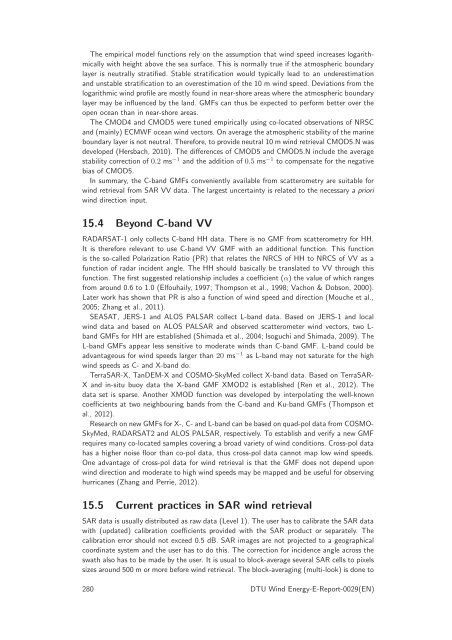Publishers version - DTU Orbit
Publishers version - DTU Orbit
Publishers version - DTU Orbit
Create successful ePaper yourself
Turn your PDF publications into a flip-book with our unique Google optimized e-Paper software.
The empirical model functions rely on the assumption that wind speed increases logarithmically<br />
with height above the sea surface. This is normally true if the atmospheric boundary<br />
layer is neutrally stratified. Stable stratification would typically lead to an underestimation<br />
and unstable stratification to an overestimation of the 10 m wind speed. Deviations from the<br />
logarithmic wind profile are mostly found in near-shore areas where the atmospheric boundary<br />
layer may be influenced by the land. GMFs can thus be expected to perform better over the<br />
open ocean than in near-shore areas.<br />
The CMOD4 and CMOD5 were tuned empirically using co-located observations of NRSC<br />
and (mainly) ECMWF ocean wind vectors. On average the atmospheric stabilityof the marine<br />
boundarylayerisnotneutral.Therefore,to provideneutral10mwindretrieval CMOD5.Nwas<br />
developed (Hersbach, 2010). The differences of CMOD5 and CMOD5.N include the average<br />
stability correction of 0.2 ms −1 and the addition of 0.5 ms −1 to compensate for the negative<br />
bias of CMOD5.<br />
In summary, the C-band GMFs conveniently available from scatterometry are suitable for<br />
wind retrieval from SAR VV data. The largest uncertainty is related to the necessary a priori<br />
wind direction input.<br />
15.4 Beyond C-band VV<br />
RADARSAT-1 only collects C-band HH data. There is no GMF from scatterometry for HH.<br />
It is therefore relevant to use C-band VV GMF with an additional function. This function<br />
is the so-called Polarization Ratio (PR) that relates the NRCS of HH to NRCS of VV as a<br />
function of radar incident angle. The HH should basically be translated to VV through this<br />
function. The first suggested relationship includes a coefficient (α) the value of which ranges<br />
from around 0.6 to 1.0 (Elfouhaily, 1997; Thompson et al., 1998; Vachon & Dobson, 2000).<br />
Later work has shown that PR is also a function of wind speed and direction (Mouche et al.,<br />
2005; Zhang et al., 2011).<br />
SEASAT, JERS-1 and ALOS PALSAR collect L-band data. Based on JERS-1 and local<br />
wind data and based on ALOS PALSAR and observed scatterometer wind vectors, two Lband<br />
GMFs for HH are established (Shimada et al., 2004; Isoguchi and Shimada, 2009). The<br />
L-band GMFs appear less sensitive to moderate winds than C-band GMF. L-band could be<br />
advantageous for wind speeds larger than 20 ms −1 as L-band may not saturate for the high<br />
wind speeds as C- and X-band do.<br />
TerraSAR-X, TanDEM-X and COSMO-SkyMed collect X-band data. Based on TerraSAR-<br />
X and in-situ buoy data the X-band GMF XMOD2 is established (Ren et al., 2012). The<br />
data set is sparse. Another XMOD function was developed by interpolating the well-known<br />
coefficients at two neighbouring bands from the C-band and Ku-band GMFs (Thompson et<br />
al., 2012).<br />
ResearchonnewGMFsforX-,C-andL-bandcanbebasedonquad-poldatafromCOSMO-<br />
SkyMed, RADARSAT2 and ALOS PALSAR, respectively. To establish and verify a new GMF<br />
requires many co-located samples covering a broad variety of wind conditions. Cross-pol data<br />
has a higher noise floor than co-pol data, thus cross-pol data cannot map low wind speeds.<br />
One advantage of cross-pol data for wind retrieval is that the GMF does not depend upon<br />
wind direction and moderate to high wind speeds may be mapped and be useful for observing<br />
hurricanes (Zhang and Perrie, 2012).<br />
15.5 Current practices in SAR wind retrieval<br />
SAR data is usually distributed as raw data (Level 1). The user has to calibrate the SAR data<br />
with (updated) calibration coefficients provided with the SAR product or separately. The<br />
calibration error should not exceed 0.5 dB. SAR images are not projected to a geographical<br />
coordinate system and the user has to do this. The correction for incidence angle across the<br />
swath also has to be made by the user. It is usual to block-average several SAR cells to pixels<br />
sizes around 500 m or more before wind retrieval. The block-averaging (multi-look) is done to<br />
280 <strong>DTU</strong> Wind Energy-E-Report-0029(EN)

















